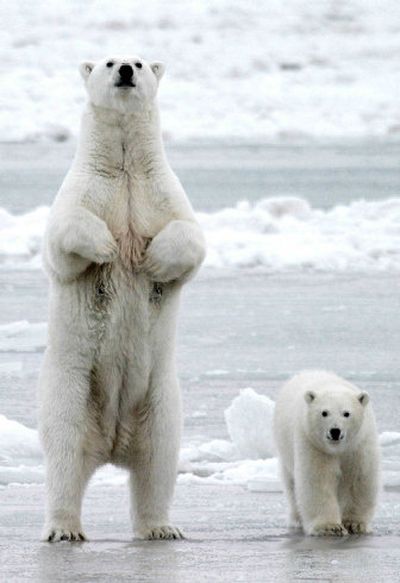Suit seeks protection for polar bears

ANCHORAGE, Alaska – Three conservation groups sued the federal government Thursday seeking to protect polar bears from extinction because of disappearing Arctic sea ice.
The groups blame global warming and sued in U.S. District Court in San Francisco to protect polar bears under the Endangered Species Act.
The lawsuit filed by the Center for Biological Diversity, the Natural Resources Defense Council and Greenpeace claims extensive scientific evidence shows sea ice is melting because of global warming.
“Global warming and rising temperatures in the Arctic jeopardize the polar bear’s very existence,” said Melanie Duchin, a climate campaigner with Greenpeace.
“Polar bears cannot survive without sea ice. Polar bears could disappear in our lifetime if we don’t take action.”
Valerie Fellows, a Fish and Wildlife Service spokeswoman in Washington, D.C., said she did not have the lawsuit before her and could not comment on its specifics.
The conservation groups hope that a listing under the Endangered Species Act would provide broad protection to polar bears, including a requirement in the law that federal agencies ensure that any action carried out, authorized or funded by the government will not “jeopardize the continued existence” of polar bears or adversely modify their critical habitat.
America’s polar bears are found in Alaska. The Beaufort Sea stock off Alaska’s northern coast is estimated at 2,000 animals. The Bering-Chukchi stock off Alaska’s northwest coast, a population shared with Russia, is estimated at 2,000 to 5,000 animals. They spend most of their lives on sea ice.
There is no hard count of polar bears, and the lawsuit offered no estimate of how many animals may have been lost because of retreating ice.
A joint announcement in September by the University of Colorado’s National Snow and Ice Data Center, NASA and the University of Washington declared a “stunning reduction in Arctic sea ice at the end of the northern summer.”
The center concluded that if current rates of decline in sea ice continue, the summertime Arctic could be completely ice-free well before the end of this century.
The conservation groups say global warming is caused by heat-trapping pollution such as carbon dioxide emissions from cars and trucks, power plants and other sources that accumulate in the atmosphere and prevent the sun’s heat from escaping. The United States is blamed for 20 percent of the world’s emissions, more than any other country.
The Center for Biological Diversity petitioned in February to have the polar bear listed as threatened.
The Endangered Species Act requires that the secretary of the interior respond within 90 days of receiving such notice to determine if a petition has merit. However, the agency has maintained that the lack of money and the number of petitions allows it only to respond to cases backed by a court order. It has taken no action on the February petition.
“Threatened” under the law means a species is likely to become endangered in the foreseeable future. “Endangered” means a species is in danger of extinction throughout all or a significant portion of its range.